Eat Like a Centenarian
Want to know the secrets to staying strong and full of life into your 80s and 90s and even past 100? Take a lesson in healthy eating and balanced living from five of the world’s longest-living populations — Japan, Iceland, Israel, Singapore and Italy — where many residents live vibrantly beyond 100 years.
Beth Lipton Apr 3, 2018
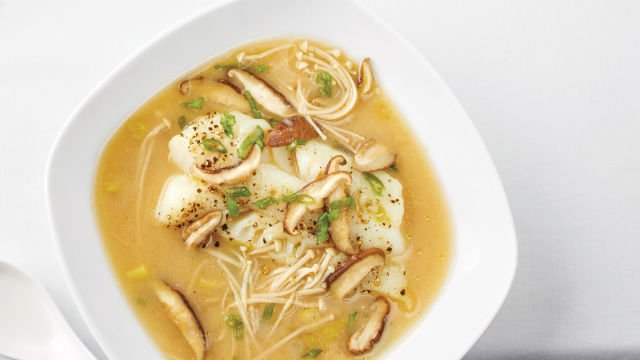
Roasted Cod & Mushrooms in Miso Broth (Japan)
Photo by Crayola England
Japan
Life expectancy: 80 for men, 87 for women
Japan has the highest number of centenarians per capita (0.05% of the population), with more than 67,000 Japanese people who’ve reached 100 years old and beyond.
Though lifestyle factors such as stress levels and habits such as smoking and drinking alcohol always play a role, the longevity enjoyed by the Japanese – the highest in the world, says the World Health Organization – has a strong link to diet, according to a study published in The BMJ in 2016. “Individuals with closer adherence to the Japanese dietary guidelines had a lower risk of death from all causes and cardiovascular disease, particularly cerebrovascular disease,” the researchers concluded. “Our findings suggest that balanced consumption of energy [calories], grains, vegetables, fruits, meat, fish, eggs, soy products, dairy products, confectionaries and alcoholic beverages can contribute to longevity by decreasing the risk of death, predominantly from cardiovascular disease, in the Japanese population.”
The traditional Japanese diet contains superfoods such as mineral-rich seaweed and a host of gut-supportive fermented foods such as miso, shoyu and umeboshi, a type of pickled plum often added to sauces or served as a condiment. Modest portions and few processed foods also play a role in the healthfulness of the traditional Japanese diet. In addition, the food is often artfully presented, and studies suggest that an attractive presentation of food with an array of colors and textures can positively influence a more varied diet. Culturally, Japanese people also take the time to appreciate their food by eating more slowly and savoring their meals.
Given that Japan is surrounded by ocean and has many rivers running through it, it’s no wonder that fish, whether raw or cooked, is a major component of Japanese cuisine. Along with cod, Japanese meals often feature salmon, sea bream, tuna, mackerel, yellowtail, shrimp and squid, says Hiroko Shimbo, Japanese food expert, author and chef-instructor at the International Culinary Center. This roasted cod in a gingery broth contains many of the hallmark health features of Japanese cuisine such as miso and kombu seaweed.
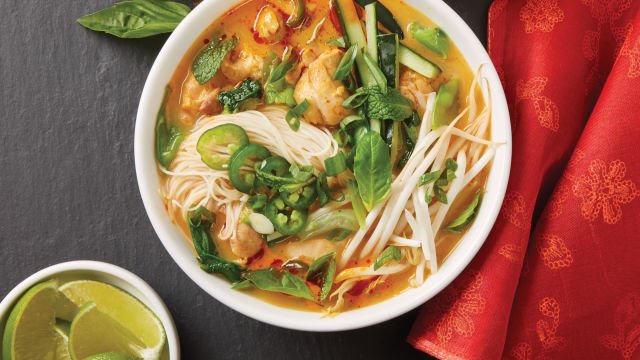
Chicken Laksa with Brown Rice Noodles (Singapore)
Photo by Crayola England
Singapore
Life expectancy: 80 for men, 86 for women
The number of centenarians in Singapore increased fivefold between the years 2002 and 2015, with 0.02% of the population now having reached centenarian status.
Singapore’s location on the southern edge of the Malay Peninsula in Southeast Asia has helped make it multicultural, influenced by countries such as China, Vietnam, Thailand, India and Indonesia, and that includes its cuisine. Singaporean food, like that of other Asian countries, emphasizes vegetables and rice (or noodles), with meat taking more of a backseat. Seafood is very popular, and the cuisine also incorporates a wealth of anti-inflammatory and antioxidant-rich ingredients such as chiles and ginger as well as a host of spices such as coriander, cumin, cinnamon, turmeric, cardamom and fennel seed. Plus, eating in Singapore is a group event. “Shared meals mean moderate portions instead of huge mounds of food at each sitting,” notes Sylvia Tan, author of Singapore Heritage Food (Landmark Books PTE. Ltd., 2014). In addition, Singapore has a uniquely successful health-care system that combines public and private services and a mandate that workers place a percentage of their earnings into a medical savings account, with a matching contribution by their employers.
It may take a bit of effort to track down some of the more unusual ingredients in this spicy, rich, coconut-laced noodle soup, but it’s worth it for the explosion of flavors in the finished product. Make it with store-bought red chile paste, or use our recipe for an even more complex and flavorful broth.
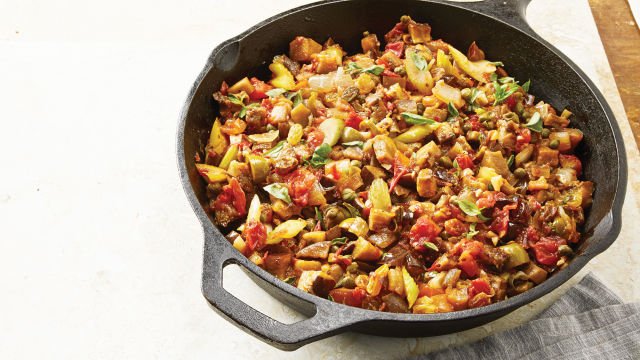
Classic Caponata (Italy)
Photo by Crayola England
Italy
Life expectancy: 80 for men, 85 for women
An impressive 0.03% of Italy’s population are centenarians – the second-highest per capita in the world – with the majority concentrated in the south of the country, including the islands of Sicily and Sardinia.
It’s no secret that the Mediterranean Diet is one of the healthiest in the world, with its emphasis on fresh, seasonal produce, fish and healthy fats such as olive oil and nuts. Herbs and spices also factor heavily into Italian cuisine, adding additional health benefits; garlic, for example, is antibacterial and cardioprotective, while rosemary contains compounds that are anti-inflammatory, cancer-fighting and memory-boosting. Lifestyle factors also play a role in the healthfulness of Italians; there, it's culturally ingrained that meals involve social exchange and community, which can help improve communication and reduce stress, boosting overall health.
This piquant relish known as caponata, made with eggplant, onions, celery, capers and generous amounts of olive oil and vinegar, embodies its home island of Sicily off the southern coast of Italy. It's sweet and sour, complicated and dramatic. Eat it warm or cold, spread it on crostini, spoon it on top of grilled chicken or fish, or fold it into an omelette. It's worth noting that there are even more centenarians in the mountainous areas of Sicily, where caponata originated, than in many other parts of Italy. We can't say this dish will guarantee a 100-candle cake in your future, but it certainly can't hurt!
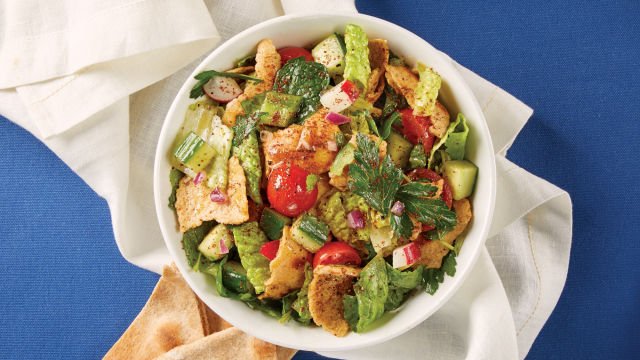
Fattoush Salad with Sumac Pita Crisps (Israel)
Photo by Crayola England
Israel
Life expectancy: 81 for men, 84 for women
When most people think of the Mediterranean diet, they think of Southern Europe – but, interestingly, Israelis also enjoy the longevity benefits of a similar diet. The local cuisine combines influences from other Middle Eastern countries as well as Eastern European and North African nations whose immigrants helped populate Israel. Popular dishes such as hummus, falafel, tabbouleh (a bulgur and parsley salad) and shakshouka (a tomato, onion and egg dish) emphasize vegetables, legumes and fresh herbs. In fact, vegetables play such a central role in Israel’s diet that it’s very common for Israelis to eat salad for breakfast! Israel’s location near the sea and relatively close location to the equator (between 29 to 33º N) also may contribute, as studies show that living in coastal communities or at a distance less than 40º from the equator increases life expectancy. The country’s low alcohol consumption, access to quality health care and 94% vaccination rate also factor in.
This herbed salad with crunchy pita, known as fattoush, is eaten widely around the country. The root of the word fattoush comes from the Arabic word fatta, which refers to the crumbling of the flatbread or pita. Traditionally made with stale pita, in this version the bread is lightly toasted and tossed with olive oil and a touch of the tart, acidic spice sumac before it’s tossed into the salad.
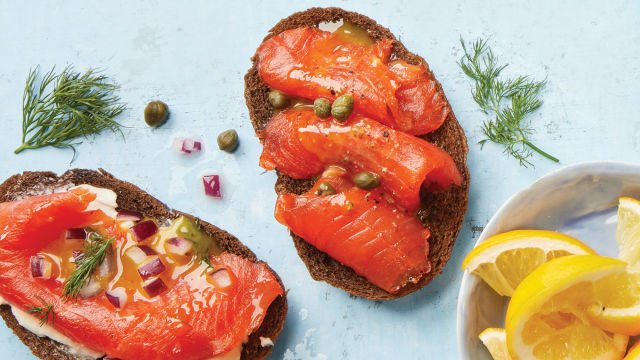
Icelandic Graflax (Iceland)
Photo by Crayola England
Iceland
Life expectancy: 81 for men, 84 for women
Given the harsh climate and dark winters, it may seem counterintuitive that Iceland enjoys one of the world's highest rates of longevity, but several factors contribute.
Not only is the tap water exceptionally clean and rich in minerals, but Icelanders also enjoy bathing in outdoor geothermically heated hot springs. These pools serve as gathering places, so locals soak in minerals as well as the social interaction that contributes to their wellbeing. Icelanders also exercise more than other Europeans, with more than 60% of the population getting physical for more than 150 minutes per week outside of work.
Iceland has access to fresh produce year-round, thanks to geothermically heated greenhouses. Locals frequently eat free-range lamb and grass-fed dairy products, especially skyr, a strained yogurt-like cheese. But fish is the food that factors most heavily in their cuisine, whether covered in cheese and bread crumbs and baked, cooked into a stew, cured or fermented.
In fact, curing, fermenting, smoking and other preservation methods became traditional thanks to the country’s long winters. Those preservation methods live on, as evidenced by the popularity of this salt-cured dish known as graflax. It's typically served with dark rye bread and eaten with a honey-mustard sauce known as graflaxsósa, or graflax sauce.
Source: https://www.cleaneatingmag.com/clean-diet/eat-like-a-centenarian
Reproduction rights CC BY 4.0 License (Attribution - Sharing under the same conditions)
I follow all the people who follows me! (If I have time, enough bandwidth and steem power...)

My 10 favorite posts:




 Green Cleaning - Clean your clothes and improve indoor air quality with this all-natural laundry detergent.
Green Cleaning - Clean your clothes and improve indoor air quality with this all-natural laundry detergent.
 A very sexy cute cosplay for you!!
A very sexy cute cosplay for you!!
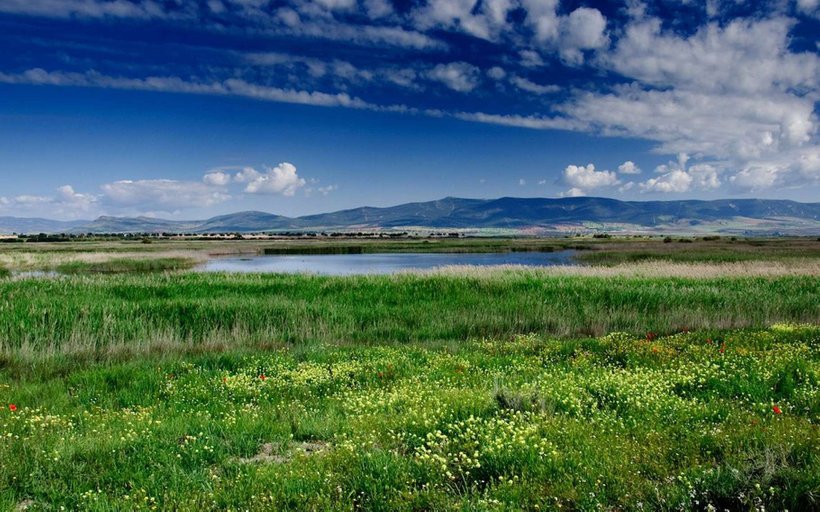 When biodiversity falls below the vital minimum
When biodiversity falls below the vital minimum


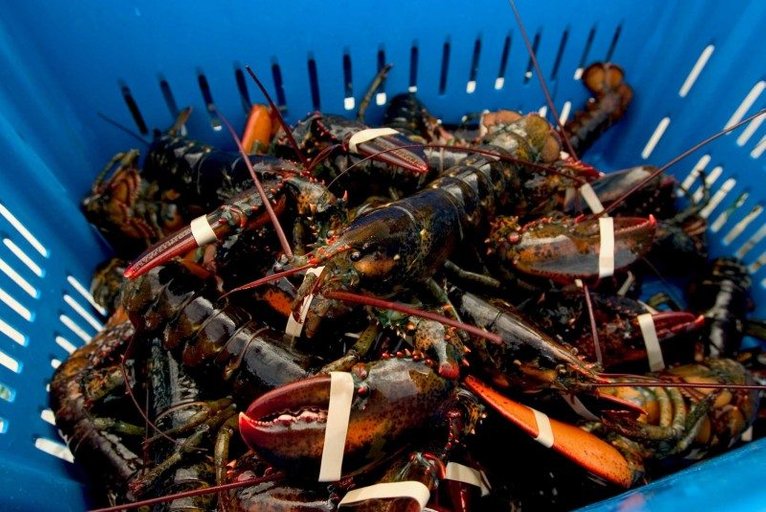 Shrimp and lobster are as bad for the climate as eating beef
Shrimp and lobster are as bad for the climate as eating beef




All the pictures posted here are free pictures found on free websites, public instagram accounts or from websites allowing the sharing of their posts
Reproduction rights CC BY 4.0 License (Attribution - Sharing under the same conditions)